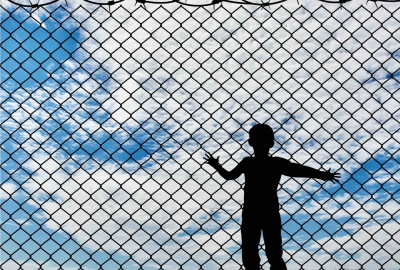
A statement by Global TIES for Children:
The current crisis at the southern border of the United States is a refugee crisis, provoked by immigration policies across administrations. As scientists who study children’s development in some of the most volatile and violent contexts in the world, we feel compelled to share what we have learned over the course of our own work in Syrian refugee response countries, in Central America, on the Nigerien border under attack by Boko Haram, and in conflict-affected provinces of the Democratic Republic of the Congo (DRC). We feel this perspective offers vital understanding of what drives families to flee their homes, risking separation, deportation, and even death. At the same time, to best support children in recovering from these events, it’s important to understand the science of resilience – the concrete evidence of what it takes for children to thrive despite adversity. The bottom line: The new U.S. immigration policy and proposed legislative approaches are the opposite of what we know are necessary to support children’s health and well-being, potentiating catastrophic consequences that can last a lifetime.
Many families are making the difficult decision to leave home – risking a perilous journey to the border and deportation and separation at the border – out of fear. In a study of undocumented migrants from El Salvador, Guatemala, and Honduras – along with Mexico, the four countries from which a majority of undocumented migrants arrive in the US – 83% of the 230 parents in the study cited violence as a reason for fleeing their home country. The types of violence parents reported experiencing were severe, including the murder of a family member (32%), death threats towards themselves (45.4%) or other family members (51.9%), extortion (33%), and domestic violence (29%). Based on their own review, the study’s authors found that fully 70% of the participants in the study met the criteria for asylum.[1] We find this particularly concerning given legislation recently introduced in the House of Representatives that seeks to cut the number of people allowed to seek humanitarian protection in the United States by narrowing the grounds for asylum and eliminating asylum protections for unaccompanied minors.[2]
Despite such exposure to violence and adversity in their home countries and in transit, a majority of children demonstrate remarkable resilience in the context of protective supports. Research going back to World War II has shown that exposure to violence – armed conflict, community violence, and domestic violence – can pose enduring threats to children’s physical, academic, social, and emotional development.[3] Yet we now know that experiences of adversity are far from destiny: Children can demonstrate substantial resilience to even severe trauma in the context of supportive and protective neurobiological, individual, family, and community systems.[4] A large body of research has identified several key “sources” of resilience within such systems that are critical to promoting children’s learning and well-being, including first and foremost:[5]
- Positive attachment bonds with parents/caregivers
- Positive relationships with nurturing adults
- Cognitive and self-regulation skills
- Faith, hope, and a sense of meaning
- Bonds to safe and supportive school settings
- Communities with safe and supportive services for families and children
In our own research with the International Rescue Committee in the DRC, Lebanon, and Niger, we have seen firsthand the power of such systems to promote refugee and displaced children’s learning and well-being.[6] For example, research by colleagues in the DRC suggests that a positive, cooperative, and predictable school environment can act as a buffer, protecting children’s social-emotional well-being in the context of community violence.[7] We also know that supportive youth programming can address violence and improve youth academic and other outcomes in countries such as El Salvador.[8]
Conversely, children are most vulnerable when the multiple systems designed to protect them break down or fail. In our study in the DRC, for example, schools that failed to provide a positive, supportive, and nurturing environment worsened mental health symptoms and experiences of victimization among children who experienced violence in their communities. These findings echo those of a larger body of research on “cumulative risk.”[9] Across several large, well-designed studies, researchers have found that the experience of multiple adversities over time across the family, school, and community systems meant to protect them overwhelms children’s adaptive capacities, increasing the risk in adulthood of suicide, mental health problems, aggression, cancer, heart disease, to name only a few.[10] Indeed, a recent systematic review published in the Lancet on risk and protective factors for refugee children resettled in high-income countries finds that while pre-migration exposure to violence can contribute to emotional distress in childhood, what is of “pivotal importance” in determining children’s longer-term outcomes is children’s repeated exposure post-migration to threat, violence, and deprivation, including through prolonged family separation.[11]
The science of risk and resilience is clear: a multi-pronged approach is needed to ensure children’s long-term health and well-being. That is, it is imperative to prevent threats and violence in home and host countries, while also capacitating and supporting children’s, families’, schools’, and communities’ inherent strengths.
In the context of the current crisis, we recommend:
- Keeping families together at the border and during the entire determination process[12]
- Building protective settings for children, youth and families exposed to violence in home and host countries
- Bolstering economic supports for in home countries for full young adult employment and pathways through education and family interventions to alternatives from violence[13]
Current U.S. immigration policy and proposed legislation is the opposite of what we know is good for children. It will both provoke stress among children who have already experienced unspeakable adversities, while overwhelming and destroying the systems that can protect children’s health, learning, and well-being. Delays in reunifying children with their parents, placing children long-term in detention facilities that have been the focus of thousands of complaints of physical and sexual abuse, denying access to key health and social supports – such legislated and comprehensive deprivation after experiences of fear and violence ensures that these children will never have the chance to fully live healthy and productive lives.
Failing these children would not amount simply to a moral failure on our part. It will provide the fertile conditions for the reproduction of the very violence and trauma that has led to this crisis in the first place.
This post was written by Dr. Carly Tubbs Dolan, Director of Measurement and Metrics at the Education in Emergencies: Evidence for Action initiative, on behalf of Global TIES for Children.
About Global TIES for Children: Global TIES for Children is an international research center embedded within IHDSC. At Global TIES for Children we design, evaluate and advise on programs and policies to improve the lives of children and youth in the most vulnerable regions across the globe. We work with some of the world’s leading non-governmental organizations (NGOs) and with governments in low-income and crisis-affected countries on developing and evaluating innovative approaches to promoting holistic development of children and their communities.
References:
[1] Keller, A., Joscelyne, A., Granski, M., & Rosenfeld, B. (2017). Pre-migration trauma exposure and mental health functioning among Central American migrants arriving at the US Border. PLOS ONE, 12(1), e0168692. https://doi.org/10.1371/journal.pone.0168692
[2] Pierce, J. B., Sarah. (2018, June 14). House bills would largely dismantle asylum system at U.S.-Mexico Border. Retrieved June 26, 2018, from https://www.migrationpolicy.org/news/house-bills-would-largely-dismantle-asylum-system-us-mexico-border
[3] Cummings, E. M., Merrilees, C. E., Taylor, L. K., & Mondi, C. F. (2017). Developmental and social–ecological perspectives on children, political violence, and armed conflict. Development and Psychopathology, 29(1), 1–10. https://doi.org/10.1017/S0954579416001061
[4] Lundberg, M., & Wuermli, A. J. (2012). Children and youth in crisis: protecting and promoting human development in times of economic shocks. Washington D.C: World Bank.
[5] Masten, A. S. (2014). Global perspectives on resilience in children and youth. Child Development, 85(1), 6–20. https://doi.org/10.1111/cdev.12205
[6] Aber, J. L., Tubbs, C., Torrente, C., Halpin, P. F., Johnston, B., Starkey, L., … Wolf, S. (2017). Promoting children’s learning and development in conflict-affected countries: Testing change process in the Democratic Republic of the Congo. Development and Psychopathology, 29(1), 53–67. https://doi.org/10.1017/S0954579416001139; Tubbs Dolan, Carly. (2018). Methods for rigorously and responsively improving children’s holistic learning and development in crisis contexts: Towards an evidence-based education in emergency field (Doctoral dissertation). New York University, New York, NY.
[7] Starkey, L., Aber, J. L., & Crossman, A. (2018, under review). Resource or risk: The role of school climate in the presence of community violence in the Democratic Republic of the Congo. Manuscript under review.
[8] Dinarte, L. (2017). Peer effects in after-school programs: Experimental evidence in El Salvador (Doctoral dissertation). Universidad Catolica de Chile, Chile.
[9] Rutter, M. (1979). Protective factors in children’s responses to stress and disadvantage. Annals of the Academy of Medicine, Singapore, 8(3), 324–338; Evans, G. W., Li, D., & Whipple, S. S. (2013). Cumulative risk and child development. Psychological Bulletin, 139(6), 1342.
[10] Dube, S. R., Anda, R. F., Felitti, V. J., Chapman, D. P., Williamson, D. F., & Giles, W. H. (2001). Childhood Abuse, Household Dysfunction, and the Risk of Attempted Suicide Throughout the Life Span: Findings From the Adverse Childhood Experiences Study. JAMA, 286(24), 3089–3096. https://doi.org/10.1001/jama.286.24.3089
[11] Fazel, M., Reed, R. V., Panter-Brick, C., & Stein, A. (2012). Mental health of displaced and refugee children resettled in high-income countries: risk and protective factors. The Lancet, 379(9812), 266–282. https://doi.org/10.1016/S0140-6736(11)60051-2
[12] Stipulated settlement agreement at 3, 7–18, 20, Flores v. Reno, No. CV 85-4544- RJK(Px) (C.D. Cal. Jan. 17, 1997), available at http://www.aclu.org/files/pdfs/immigrants/ flores_v_meese_agreement.pdf
[13] Yoshikawa, H., Chaudry, A., Kabay, S.B., & Ramachandran, A. (2018). A transformative child-centered policy proposal for the first decade of life in El Salvador (report to the UNICEF country office for El Salvador). New York: NYU Global TIES for Children Center.

